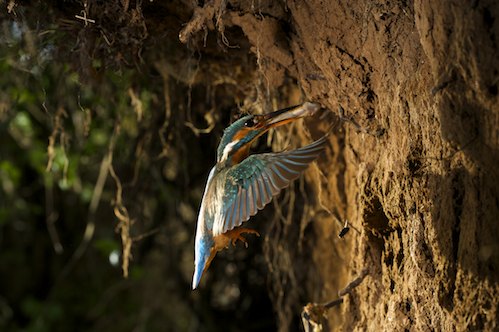One of the big problems working in Britain is that the sun is rather shy. As I'm obsessed with light it causes me real problems and I am more often than not forced to use strobes to mimic good sunlight. This is quite possible small scale but not big scale. For the shot above I had no choice however - the kingfishers were nesting under a dark overhang that never saw the sun. I was very keen to use the sun in the background though - to cast some light and give it some depth. It was a grey old week though and I was forced to light the entire shot artificially. Here's how I did it.
Firstly I got myself a Schedule One license for Natural England - this allows me to photograph kingfishers at the nest - It is illegal to do work on kingfishers at the nest without one.
Then I worked out my angles - At first I started shooting wide shots, getting the birds very close to the camera but keeping the lens very wide. Working remotely meant I was sitting in my hide on the other side of the river and my camera was on a 50ft cable on a tripod next to the nest. To make this cable I simple bought a role of thin 3 core black wire from Maplin or B&Q, snipped it, snipped my standard Canon cable release and wired the two together - twisting each wire round its corresponding wire and then sealing with insulating tape. The three wires in the cable release do two things - two of them when touched form a short to instantly take a picture - the third sends a pulse to wake the camera up. I tend to use all three when putting patch cables into cable releases as it means that the camera can be set to shut down and by half depressing the button on the release I can wake the camera up again (or trigger the autofocus). I use just two for other applications such as camera traps when I want the camera to just take pictures and not worry about auto focussing or turning on and off.
.jpg) |
| The light was nice but the bird wasn't frozen by the flash. |
I purservered with this shot for a couple of days but eventually was forced to give up by the sun not shinning. Instead I went for close-ups. They didn't require sunlight but they did require lots of strobes. They also required much faster reactions from me - the wides are slightly more forgiving when trying to get a very fast bird nicely framed.
The first thing I did was stick my all time favourite lens on - Canon 100 mm Macro - it's not the expensive L Series one but it is stunningly sharp with great contrast. I will use this lens above all others if I can. I moved the tripod back to about 5 ft from the nest and framed up on where I hoped the bird would be as it arrived at the nest entrance - I also prefocused the lens to where I thought its eye would be. To light the shot I used five flashguns. The first was the key light. This was a Canon 580 ex. I taped a single layer of warm-up gel onto it and set it to 1/8th power (fast enough to freeze the action). I magic armed this strobe up and to the right of the bird and camera. I then put a second flash off to the left of camera. This was a Vivitar 283 with Varipower unit set to 1/16th power. I put a Stoffen diffuser on this flash to really soften it. I also attached a slave unit to trigger it from the Canon flash (you need to set you Canon flashguns to 2nd curtain sync to make them work with other brand guns on slaves). A third flash was placed about 12ft from the bird off to left of cam (about 80 to 90 degrees). This just had a single warm up filter on it. I spent a lot of time fiddling with flash outputs to get the balance right - I wanted the key light to do the work but I didn't want it to look like a nasty great flashgun.
 |
| The balance of flashguns here is wrong - the bird doesn't stand out and the background is flat |
.jpg)

Stunning photographs.
ReplyDeleteThis comment has been removed by the author.
ReplyDeleteCool photographs
ReplyDelete